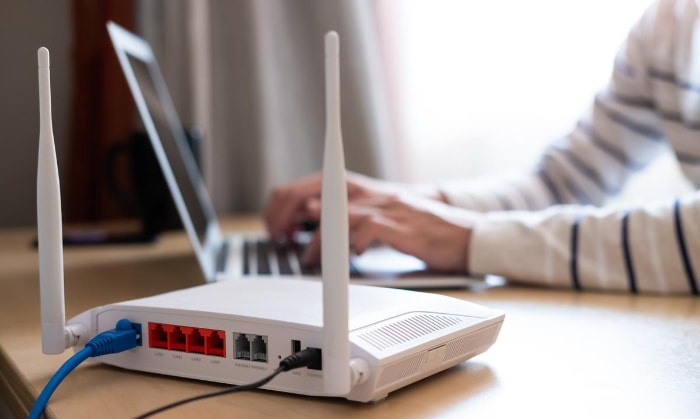WiFi 4 vs. WiFi 5 vs. WiFi 6: Speeds That Change the Game

As technology advances, new WiFi standards emerge to meet the growing demands of faster speeds, more reliable connections, and better support for multiple devices. WiFi 4, WiFi 5, and WiFi 6 represent three significant leaps in wireless connectivity, each introducing innovations designed to improve performance and user experience.
But what exactly sets these standards apart, and how do they impact your day-to-day internet usage?
Technical Foundations and Capabilities
WiFi technology has advanced significantly over the years, bringing faster speeds, improved reliability, and enhanced efficiency to networks used by homes and businesses alike. Each new standard builds upon the previous one, introducing features designed to address growing demands such as higher device density and more bandwidth-intensive applications.
Maximum Theoretical Speeds
Speed is one of the most noticeable upgrades across WiFi generations, with each standard delivering progressively faster data rates to support modern internet activities. WiFi 4, launched in 2009, is capable of maximum theoretical speeds of up to 600 Mbps.
WiFi 5 marked a significant leap forward, with theoretical speeds reaching up to 3.5 Gbps. This enhancement was fueled by a focus on higher bandwidth demands, catering to activities like 4K video streaming and online gaming.
WiFi 6 pushes the limits even further, providing speeds as high as 9.6 Gbps. While most residential or business users won’t fully utilize these maximum speeds, they highlight WiFi 6’s capacity to support numerous devices and high-bandwidth workloads simultaneously.
Frequency Bands and Channel Width
Frequency bands and channel width play a crucial role in determining how effectively a network can maintain fast and stable connections. WiFi 4 operates on both the 2.4 GHz and 5 GHz frequency bands, with channel widths of up to 40 MHz.
The inclusion of the 2.4 GHz band ensured longer-range coverage, though it came with the downside of increased interference due to heavy usage by older devices and appliances.
WiFi 5 primarily operates on the 5 GHz band, which offers reduced interference and higher capacity for data transmission. With channel widths extending up to 160 MHz, WiFi 5 benefits from wider data pipelines that enable faster speeds.
WiFi 6 retains dual-band functionality, utilizing both 2.4 GHz and 5 GHz bands, and also supports channel widths of up to 160 MHz. By maintaining the versatility of dual-band connectivity while optimizing for modern needs, WiFi 6 strikes a balance between range and performance.
Signal Range and Stability
Signal range and stability are critical factors that influence network performance, particularly in larger spaces or environments prone to interference. WiFi 4 delivers satisfactory coverage within medium-sized areas but can struggle with signal degradation as distances increase or obstacles such as walls and furniture come into play.
Its reliance on the crowded 2.4 GHz band further impacts overall stability.
WiFi 5 improves stability by concentrating on the less congested 5 GHz band, which is less susceptible to interference from household devices. However, the higher frequency also means reduced signal range compared to 2.4 GHz, limiting its effectiveness across larger distances.
WiFi 6 addresses these challenges by integrating technologies that improve signal efficiency and interference management, ensuring stable connections even in densely populated environments or spaces with numerous obstacles.
Core Technologies
Advancements in core technologies define the unique capabilities of each WiFi standard, enhancing speed, efficiency, and overall network performance. WiFi 4 introduced MIMO (Multiple Input, Multiple Output), a feature that increases data throughput by enabling devices to communicate through multiple data streams at once.
Although MIMO was revolutionary at the time, its ability to handle multiple devices was somewhat limited.
WiFi 5 expanded upon this with MU-MIMO (Multi-User MIMO), allowing routers to transmit to multiple devices simultaneously without congesting the network. WiFi 6 further enhances multi-device handling with OFDMA (Orthogonal Frequency Division Multiple Access), a technology that subdivides channels into smaller segments to boost efficiency when serving high-density environments.
Additionally, WiFi 6 incorporates 1024-QAM modulation, which increases data-carrying capacity per signal, resulting in faster and more reliable connections.
Real-World Performance Benefits

The practical performance of a WiFi network often matters more to users than the technical specifications on paper. Features like efficient battery usage, smooth compatibility with older devices, and consistent performance across different environments directly impact daily connectivity experiences.
Battery Efficiency
In a world where mobile devices have become indispensable, extending battery life has become an important consideration for WiFi connectivity. Neither WiFi 4 nor WiFi 5 provided significant features focused on battery efficiency, often leaving devices consuming power unnecessarily while maintaining their connection to the network.
WiFi 6 introduces a game-changing feature known as Target Wake Time (TWT). This technology allows routers to schedule communication times with devices, ensuring that WiFi connections are active only when needed.
Mobile devices and IoT products, such as smart thermostats or security cameras, particularly benefit from this feature, as it minimizes the amount of energy wasted on maintaining a constant connection. TWT not only extends the battery life of individual devices but also makes WiFi 6 networks more efficient overall.
Backward Compatibility
As new WiFi standards are released, it is inevitable that older devices will remain in use, raising questions about compatibility within mixed networks. WiFi 4 and WiFi 5 paved the way by prioritizing backward compatibility, ensuring newer routers could still accommodate devices built on earlier WiFi versions.
While this approach has been convenient for users, performance often suffers when older devices are added to modern networks.
WiFi 6 continues the tradition of backward compatibility, allowing it to work seamlessly with devices designed for WiFi 4 and WiFi 5. However, enhanced features like OFDMA or TWT are not supported by older devices, meaning they cannot fully utilize the efficiency improvements of WiFi 6.
In mixed-standard networks, it is common for legacy devices to slow down overall performance, as the router must allocate resources to ensure compatibility. This makes upgrading both routers and devices an important consideration for those looking to maximize the benefits of the latest technology.
Practical Applications and Use Cases

The evolution of WiFi standards is not just about technical improvements; it directly translates into real-world advantages for households, businesses, and high-demand activities. Whether powering a busy family network, enabling seamless collaboration in workplaces, or supporting bandwidth-heavy tasks like gaming or streaming, WiFi 4, WiFi 5, and WiFi 6 cater to different connectivity needs.
Home Network Scenarios
Home networks must accommodate a growing number of connected devices, ranging from laptops to smart TVs and IoT gadgets. For smaller families or households with limited devices, WiFi 4 often suffices, offering dual-band connectivity and basic speeds for casual browsing or streaming on one to two devices.
However, as more family members add smartphones, tablets, and streaming services into the mix, WiFi 4 quickly becomes less reliable as network congestion increases.
WiFi 5 is better equipped to handle the connectivity demands of modern family homes. With higher speeds and MU-MIMO technology, it provides improved support for multiple devices functioning simultaneously.
Streaming 4K movies while others browse social media or attend virtual meetings becomes far more feasible without noticeable lag or interruptions.
WiFi 6 takes smart home integration to the next level, making it ideal for households with numerous IoT devices like smart thermostats, security cameras, and voice assistants. Its ability to manage high-density environments ensures that even with dozens of devices connected, performance remains stable.
Features like Target Wake Time also conserve energy, optimizing the functionality of battery-operated smart devices. A home powered by WiFi 6 can support everything from remote work setups to entertainment systems and automation technologies with ease.
Business Environment Applications
Workplaces demand a reliable and efficient network to facilitate smooth collaboration and productivity across various devices. WiFi 4 offers acceptable performance for basic office setups, particularly in smaller businesses with fewer employees.
However, as companies scale and more devices are introduced, WiFi 4 often falters due to limited bandwidth and challenges in managing multiple users.
WiFi 5 improves office environments by providing faster speeds, reduced interference, and stronger multi-device support. It shines in settings like open-plan offices, where employees rely on laptops, printers, and other connected devices to perform tasks.
Additionally, its higher capacity makes it suitable for casual video conferencing and online collaboration tools.
WiFi 6 is particularly advantageous for large-scale or high-tech workplaces such as corporate offices, coworking spaces, or conference rooms. With its ability to handle dozens of devices simultaneously, WiFi 6 ensures smooth connections during presentations, virtual meetings, and collaborative sessions.
It also provides the reliability needed for high-bandwidth tasks like uploading large files or utilizing cloud services. Businesses adopting WiFi 6 benefit from increased efficiency in day-to-day operations and can confidently scale their infrastructure without compromising connectivity.
High-Demand Activities
Bandwidth-intensive activities, such as streaming high-resolution videos, online gaming, and handling large file transfers, pose unique challenges to networks. WiFi 4, while functional for basic tasks, struggles with the demands of high-definition streaming and latency-sensitive gaming.
Users may experience buffering, slower download speeds, and lag, especially when multiple devices compete for bandwidth.
WiFi 5 addresses these issues with faster speeds and improved performance for high-demand applications. Streaming 4K content or gaming with minimal latency becomes feasible, as WiFi 5 effectively prioritizes bandwidth allocation.
However, even WiFi 5 can encounter limitations in environments with multiple simultaneous users engaged in intensive tasks.
WiFi 6 excels at delivering superior performance for the most demanding activities. Its higher speeds, reduced latency, and advanced technologies like OFDMA ensure smooth streaming of 4K or even 8K videos while handling other concurrent tasks like cloud computing.
Gamers benefit from the low latency and uninterrupted online experiences WiFi 6 provides, even in high-traffic conditions. The ability to upload and download massive files quickly also makes WiFi 6 an excellent choice for professionals relying on cloud-based workflows.
Making the Right Choice

Choosing the correct WiFi standard for your home or business is a decision that involves balancing performance, cost, and use case needs. While upgrading to the newest standard may seem like the obvious option, factors such as budget, the scale of the network, and required security features play a significant role.
Cost Considerations
The price difference between WiFi router generations often reflects the level of innovation and hardware sophistication offered by newer models. WiFi 4 routers, with their basic features, tend to be budget-friendly and are suitable for smaller networks or users with minimal performance demands.
WiFi 5 routers, which offer faster speed and improved device management, come with a moderate price tag, making them a good mid-tier option for families or small businesses seeking reliable performance without a significant financial commitment.
WiFi 6 routers represent the premium tier, offering cutting-edge technologies like OFDMA, enhanced battery efficiency, and multi-device support. Their upfront cost is typically higher, but they provide a substantial return on investment for users who need robust performance across high-density environments or bandwidth-intensive applications.
For those with increasingly connected homes or businesses, the longevity of WiFi 6 technology ensures compatibility with future advancements, making it a worthy investment.
When to Upgrade
Upgrading a network depends on specific signs indicating that the current setup is no longer meeting expectations. Frequent lag during video calls, consistent buffering while streaming, or difficulties connecting multiple devices to the same network suggest that an upgrade may be necessary.
For users relying on outdated WiFi 4 routers, issues like limited speed or poor handling of multiple devices make upgrading to WiFi 5 or WiFi 6 an attractive solution.
Matching WiFi standards to individual needs ensures that the upgrade serves its purpose effectively. Families using several devices for streaming, gaming, and remote work may find WiFi 5 sufficient, while households with growing IoT ecosystems or businesses managing dense collaborative spaces benefit more from WiFi 6.
Recognizing existing pain points and future usage goals helps determine the most appropriate WiFi standard.
Implementation Strategies
Network setup plays a critical role in getting the best performance from a chosen WiFi standard. A single router setup suits smaller spaces, providing sufficient coverage for typical households or small offices.
However, for larger homes or workspaces, mesh network systems offer superior performance. Mesh networks use multiple access points to eliminate dead zones, ensuring consistent connectivity across multiple rooms or floors.
Optimal placement of hardware further improves performance. Routers should be situated centrally, away from walls and interference sources like microwaves or cordless phones.
WiFi 4 routers, which rely on 2.4 GHz for wider coverage, are typically less sensitive to placement issues, whereas WiFi 5 and WiFi 6 routers, operating mainly at 5 GHz, benefit from fewer obstacles in their surroundings.
Security Enhancements
Security enhancements in WiFi standards are critical for protecting sensitive data and ensuring safe connections. WiFi 4 and WiFi 5 routers typically use WPA2 (Wi-Fi Protected Access 2), which provides solid encryption but may be vulnerable to newer cybersecurity threats.
Modern routers operating on WiFi 6 support WPA3, the latest security protocol designed to offer stronger encryption and protect against brute-force attacks. WPA3 also simplifies securing public and guest networks, making it ideal for businesses that host visitors or allow external device connections.
Beyond encryption protocols, WiFi 6 introduces additional security features that enhance protections for connected devices. These improvements are particularly beneficial for IoT gadgets, which are frequent targets for cyberattacks.
Upgrading to WiFi 6 ensures that users can rely on a network that not only performs well but also minimizes vulnerabilities against emerging threats.
Conclusion
WiFi 4, 5, and 6 each represent significant milestones in the evolution of wireless connectivity, with unique features and capabilities tailored to different needs. WiFi 4 laid the foundation with dual-band support and decent speeds for its time, while WiFi 5 accelerated performance, introduced MU-MIMO for better multi-device handling, and focused on accommodating modern internet usage.
WiFi 6 takes connectivity to new heights, offering unmatched speeds, seamless handling of high-density device environments, improved energy efficiency, and enhanced security features.
For casual users or smaller households with limited devices, WiFi 4 may still provide sufficient coverage for basic tasks. WiFi 5 presents an excellent middle ground for families or small businesses that rely on multiple devices, faster speeds, and smoother streaming or gaming experiences.
For those with future-forward needs, including smart homes, IoT ecosystems, or demanding business operations, WiFi 6 stands out as the optimal choice due to its ability to handle more devices, reduce latency, and deliver robust performance under high-demand scenarios.
In making a choice, users should consider their current network demands while anticipating future requirements. Upgrading to a newer WiFi standard often brings the dual benefits of immediate improvements in performance and long-term compatibility with emerging technology.
While upfront costs may vary, the return on investment in terms of speed, reliability, and security justifies the expense for most modern users.



